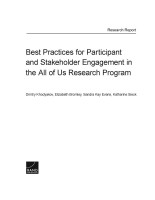| 来源类型 | Research Reports
|
| 规范类型 | 报告
|
| DOI | https://doi.org/10.7249/RR2578
|
| 来源ID | RR-2578-NIH
|
| Best Practices for Participant and Stakeholder Engagement in the All of Us Research Program |
| Dmitry Khodyakov; Elizabeth Bromley; Sandra Kay Evans; Katharine Sieck
|
| 发表日期 | 2018
|
| 出版年 | 2018
|
| 页码 | 122
|
| 语种 | 英语
|
| 结论 |
The authors identified six best practices for engagement:- Expand existing community partnerships to build awareness of precision medicine and prepare community members for considering enrollment in the AoURP.
- Foster a spectrum of leadership support to identify well-placed allies who can help with participant engagement.
- Engage a mix of study champions by involving physicians, other clinical personnel, community members, and enrolled participants.
- Make precision medicine relevant to participant and community priorities by tailoring and personalizing messages about the AoURP.
- Build an engagement team with diverse expertise by hiring staff with marketing, customer care, or public relations experience who also understand community priorities and know the clinical sites where recruitment takes place.
- Be prepared to talk about uncertainties related to the evolving nature of the AoURP.
The authors developed the three Ms of engagement framework for evaluating participant engagement process and its outcomes:- This framework distinguishes between metrics, markers, and mechanisms of engagement.
- Metrics are counts and descriptions of what was done to engage participants.
- Markers are the outcomes or benefits that engagement in the AoURP may bring.
- Mechanisms are hypotheses that link metrics and markers and try to explain how engagement activities yielded the desired outcomes.
|
| 摘要 |
Implement best practices for engagement- Expand existing community partnerships.
- Foster a spectrum of leadership support.
- Engage a mix of study champions.
- Make precision medicine relevant to participant and community priorities.
- Build an engagement team with diverse expertise.
- Be prepared to talk about uncertainties.
Evaluate engagement success using the three Ms of engagement framework- Define desired outcomes, including increased participants' trust in research, science, academic/research institutions; improved public perception of research; positive changes in health equity in the conduct of research; increased scientific literacy; increased awareness of precision medicine; and narrowing of the digital divide.
- Measure what was done to engage.
- Identify and test hypotheses about how a given engagement strategy may lead to desired outcomes.
Incorporate retention strategies commonly used in longitudinal studies- Minimize the perceived burden of follow-up requests.
- Proactively manage the samples for future projects.
- Develop a strategy for keeping participants' contact information current.
- Build relationships and stress the longitudinal nature of the project to encourage retention.
- Maintain regular contact with participants to minimize attrition.
- Tailor and personalize messages.
|
| 主题 | Biomedical Research
; Databases and Data Collection
; Analysis
; and Processing
; Electronic Medical Records
; Genomic Medicine
|
| URL | https://www.rand.org/pubs/research_reports/RR2578.html
|
| 来源智库 | RAND Corporation (United States)
|
| 引用统计 |
|
| 资源类型 | 智库出版物
|
| 条目标识符 | http://119.78.100.153/handle/2XGU8XDN/108816
|
推荐引用方式
GB/T 7714 |
Dmitry Khodyakov,Elizabeth Bromley,Sandra Kay Evans,et al. Best Practices for Participant and Stakeholder Engagement in the All of Us Research Program. 2018.
|
|
文件名:
|
x1534251951676.jpg
|
|
格式:
|
JPEG
|

|
文件名:
|
RAND_RR2578.pdf
|
|
格式:
|
Adobe PDF
|
除非特别说明,本系统中所有内容都受版权保护,并保留所有权利。